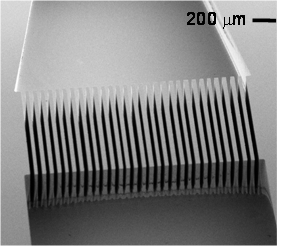Characterizing Immobilized Catalysts Using Packed-Bed Microreactors
Catalyst immobilization on heterogeneous supports affords several advantages over homogeneous catalysts for chemical synthesis in continuous flow processes. The use of packed beds in flow systems offers built-in catalyst separation from the effluent while allowing for high catalyst loadings. However, heterogeneous catalysts typically suffer from two problems: 1) reduced activity compared to the homogeneous analogue and 2) loss of activity over time due to deactivation or leaching. A requirement for using immobilized catalysts in continuous processes is an understanding of the activity and stability of the catalyst over long periods.
Towards this end, we have developed a platform for characterizing immobilized catalysts using silicon microreactors. These devices have void volumes of 28-140 µL, which allow complete characterization using milligram quantities of material. The devices are fabricated using deep reactive-ion-etching (DRIE), coated with silicon nitride to enhance chemical compatibility, and capped with pyrex to allow visual access. The microfabricated weir has 25 µm wide channels (Figure 1); thus, particles larger than 25 µm can be retained. Fluidic connections are made using a compression packaging scheme that was recently developed in our group [1] (Figure 2). Both polymer beads and silica gel have been loaded and retained, though polymer beads offer challenges due to their tendency to swell in organic solvents. Application of this system to studying covalently bound catalysts and physisorbed catalysts [2] is ongoing.
- Figure 1: Microfabricated weir for catalyst particle retention. The weir was fabricated using DRIE and resulted in 600-μm deep by 25-μm wide channels.
- Figure 2: A packaged device containing fluorous silica gel with a void volume of 54 μL. Catalyst particles can be easily loaded and unloaded as dry powders or as slurries.
References
- S. Marre, J. Baek, J. Park, M.G. Bawendi, and K.F. Jensen, “High-pressure/high-temperature microreactors for nanostructure synthesis,” J. Association for Laboratory Automation 14 (6) 367-373 (2009). [↩]
- K.D. Nagy, L. Johansen, M. Melchiore, D.W. Young, and K.F. Jensen “Catalyst Screening using Fluorous Physisorption in Packed-Bed Microreactors,” presented at the 239th National Meeting of the American Chemical Society, San Francisco, CA, 2010 [↩]

